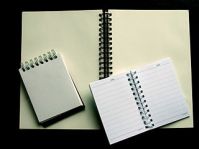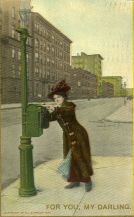
Last Saturday, I planned to clear off another bookshelf, sorting the keepers from the yard sale material, but on that shelf was a tiny Acoma pottery cat that needed to travel to a friend in New Mexico. Wrapping it meant that I ended up clearing out a desk drawer instead.
I have a treasure-chest drawer of wrapping paper and all-occasion cards. I found what I needed, then ruthlessly cut my stash in half, but I kept a good quantity nonetheless. The cards are important. Ordinarily, I do little on paper. I prefer e-books on my Nook to paperbacks, and I have students submit work through an online course management system. All files for my job are electronic. But once in a while, an object made of paper means more than anything electronic could. The postcard a friend sent me of a double-rainbow over Turtleback Mountain has a life story. Time and touch went into it, and even travel. I look at it where it sits magnetized to the fridge far more often than I do any pictures stored electronically.
After the cards drawer, I decided I could do one more drawer. I thought it held old journals I could recycle without a second thought. However, I double-checked inside the notebooks. The journals were long gone. These notebooks from about twelve years ago contained a novel scribbled by hand in the evenings while I lived in Norfolk. I wrote with no thought of publication, no thoughts of anything except the need to write a story. A quick glance at a few pages showed some dialog that surprised me. I expected it to be terrible. After all, it was a first draft not intended for an audience. Oddly enough, my candid, handwritten work had some merit, a freedom that eludes me with my obsessive revising on my computer. By hand, I wrote love scenes without hesitation. I wrote characters with more of myself in them than I do now. This was fiction as a dress rehearsal for changes I needed to make in my life, an exploration of how I felt and what I wanted. Of course, if I typed it up, I would see it with fresh eyes as the unpolished material it is, and it would possibly turn out to be drivel. I may also find the root of another book in it, and the foundations of usable characters.
I wrote a message on the paper card, a reproduction of a work of art that hangs on my wall, a card printed by the artist. My words were few and possibly drivel. You can’t revise a card, though, not when you’ve used one from your cherished collection. Off it goes. Published to one person.
